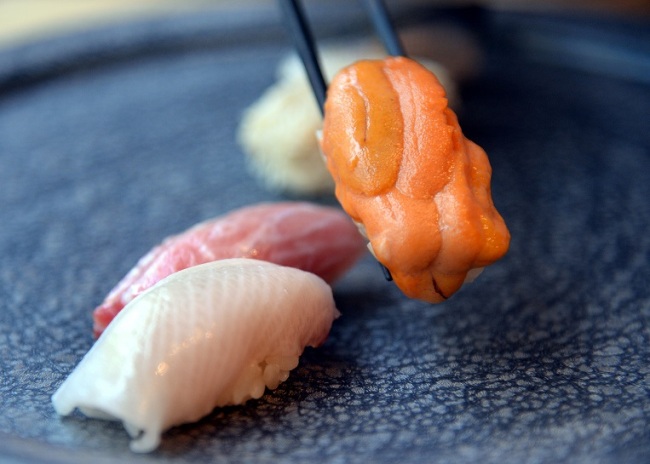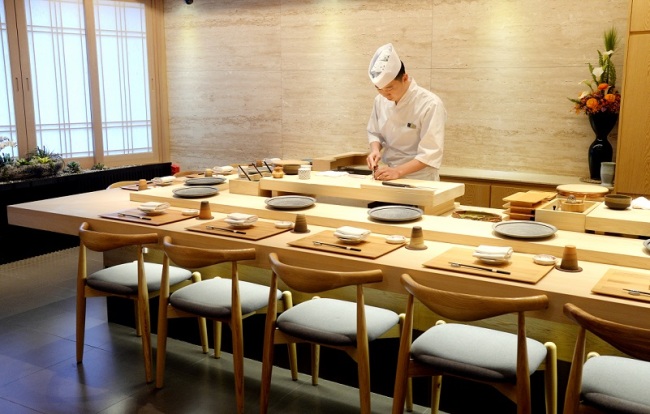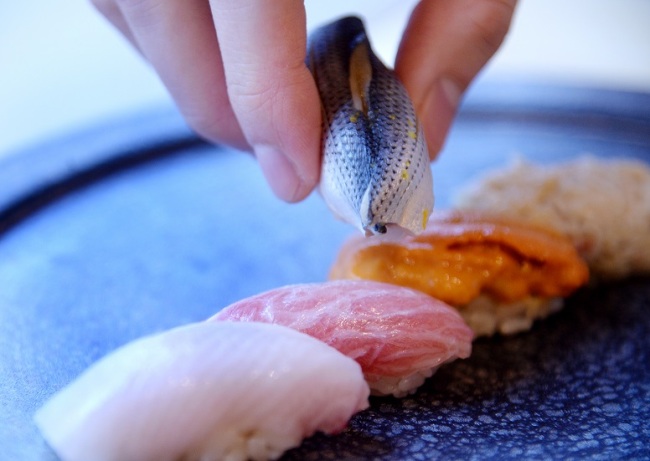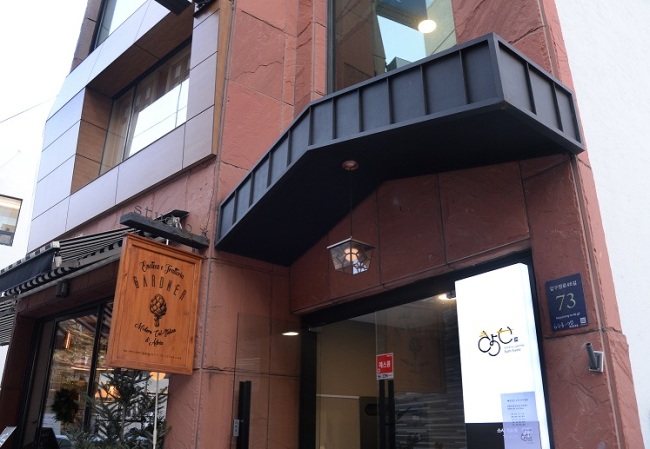Seamless, delicate, fragrant sushi at Kiyose
New sushiya specializes in Edo-style sushi
By Jean OhPublished : Dec. 15, 2017 - 17:21
Sushi Kiyose, one of the newest sushiya to open in Seoul, is much like its name -- a serene space where one can slowly savor the soft, delicate wash of flavor from each piece of sushi with small dishes that also merit the same degree of near-meditative consideration.
“I wanted a pristine space where one could come and quietly enjoy sushi, hence the name ‘kiyose,’ which means ‘clear ford,’” explained head chef Lee Sung-jun, 34.
Hinoki wood, the same fragrant wood used in temples, palaces and onsen in Japan, has been used to create a counter that seats less than 10.
“I wanted a pristine space where one could come and quietly enjoy sushi, hence the name ‘kiyose,’ which means ‘clear ford,’” explained head chef Lee Sung-jun, 34.
Hinoki wood, the same fragrant wood used in temples, palaces and onsen in Japan, has been used to create a counter that seats less than 10.

From behind that counter, Lee, who has been honing his skills for 16 years, slices and prepares Edo-style sushi, a delicacy that is essentially constructed from two main components -- “shari” (sushi rice) and “neta” (the topping).
The sushi rice, called “shari,” is customarily seasoned with rice vinegar, sugar and salt and kept at a specific temperature.
At Kiyose, Lee says that salt, a tiny bit of sugar, “kombu” (kelp) and two different kinds of rice vinegar are used to make their “shari,” which is kept between 36 to 40 degrees Celsius, a temperature that Lee likens to the body’s natural temperature.

Then there is the “neta” -- the topping -- which can be aged, pickled, marinated, seasoned or slightly grilled.
Kiyose’s “nishin” (herring) sushi, for instance, features small dabs of micro leeks and shiso nestled under an oval of herring, which has been lacquered with not one but several sauces, including a “secret sauce.” Then, a small sphere of grated ginger is used to top the “neta.”
Each element plays its role -- the glutinous warmth of the “shari” and that soul-pleasing fragrance of the shiso, so vibrant on the palate, which melds with the rich mineral flavors of the herring itself, followed by the refreshing, pinching heat of ginger.

That same attention to detail shines through with the “anago” (sea eel) sushi, which has not only been lacquered with sauce, but also decorated with a fragrant and beautiful sansho leaf.
Lee, however, does not believe in adding more components to his sushi than necessary.
One of his most delicious sushi is fairly minimal, warm “shari” topped with a “neta” of crab meat seasoned with “kani miso” (crab guts). Nothing else is used to season the “neta,” said Lee.
Then there are the dishes interspersed throughout the omakase meal, from small bowls filled with everything from a beautiful pairing of creamy, sweet “uni” (sea urchin) and soft slices of gossamer-like “aori ika” (bigfin reef squid) showered judiciously with grated “yuzu” (Citrus junos) to dense and rich slices of “ankimo” (monkfish liver) topped with “momiji-oroshi” (grated daikon infused with red chili).

Fragrant, aromatic touches play a memorable role at Kiyose, from the violet shiso flowers adorning a creamy “chawanmushi” (egg custard) at the beginning of the meal to the citrusy touches of “sudachi” (a green citrus) here and there to the myoga ginger perfuming the miso soup served in the middle of the meal.
Lee, who is dedicated to making authentic Edo-style sushi, hopes to source more diverse ingredients from both Korea and Japan as he continues to put down roots at this new eight-month-old sushiya in Sinsa-dong and it will be interesting to see how his style evolves over time.
“I want people to find happiness in eating sushi,” said Lee.
Sushi Kiyose
2F, 648-20 Sinsa-dong, Gangnam-gu, Seoul
(02) 511-2585; www.sushikiyose.com
Open noon to 3 p.m., 6 p.m. to 10 p.m. daily, closed Sundays
Lunch omakase sushi course costs 90,000 won, lunch omakase sashimi course costs 110,000 won, dinner omakase course costs 180,000 won
Reservations recommended
2F, 648-20 Sinsa-dong, Gangnam-gu, Seoul
(02) 511-2585; www.sushikiyose.com
Open noon to 3 p.m., 6 p.m. to 10 p.m. daily, closed Sundays
Lunch omakase sushi course costs 90,000 won, lunch omakase sashimi course costs 110,000 won, dinner omakase course costs 180,000 won
Reservations recommended
By Jean Oh (oh_jean@heraldcorp.com)



![[Herald Interview] 'Amid aging population, Korea to invite more young professionals from overseas'](http://res.heraldm.com/phpwas/restmb_idxmake.php?idx=644&simg=/content/image/2024/04/24/20240424050844_0.jpg&u=20240424200058)












![[KH Explains] Korean shipbuilding stocks rally: Real growth or bubble?](http://res.heraldm.com/phpwas/restmb_idxmake.php?idx=652&simg=/content/image/2024/04/25/20240425050656_0.jpg&u=)

